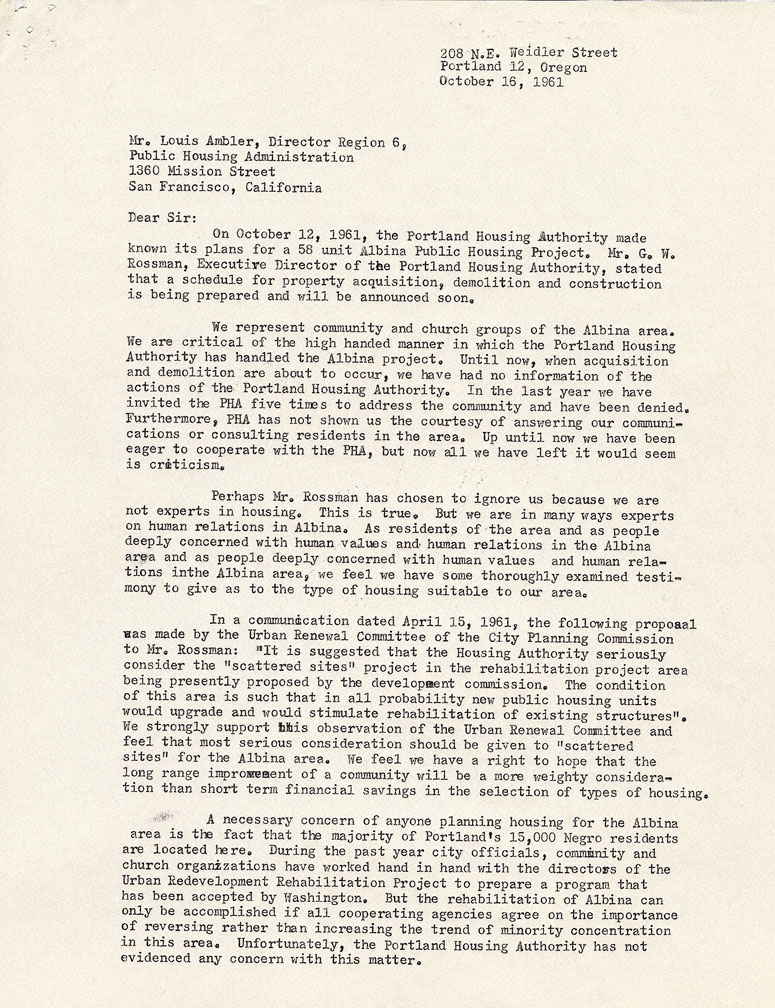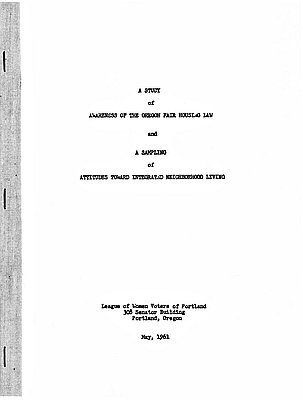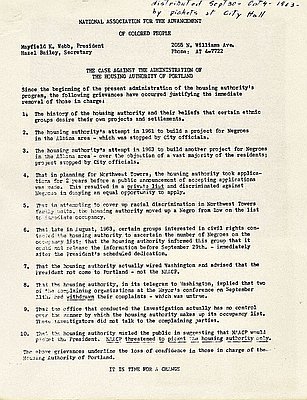This October 16, 1961, letter was sent to Louis Ambler, Regional Director of the Federal Housing Administration in San Francisco, to protest the Housing Authority of Portland’s (HAP) plans to build a 58-unit housing project in the Albina neighborhood. It was signed by, among others, leaders of the Urban League of Portland, Portland Branch of the National Association for the Advancement of Colored People (NAACP), and Albina Neighborhood Community Council.
On October 3, 1961, HAP announced it would construct a 58-unit low-rent housing complex on two blocks running alongside NE Rodney Avenue between Knott and Stanton streets (see “Detail” image). While HAP Executive Director Gene W. Rossman argued that the project would “be of particular benefit to the improvement of the Albina area,” organized resistance began immediately. Some local advocacy organizations agreed on the need for public housing assistance in Albina, but argued for “scattered sites” projects that spread a network of smaller housing complexes throughout the neighborhood. The same groups also united behind the position that construction of a large, low-rent housing project in the predominantly African-American Albina neighborhood only perpetuate a long history of residential segregation and threaten to increase the population density of an already over-crowded, high traffic area.
Project opponents nearly convinced HAP to cancel its plans. Only direct appeals for HAP to move ahead with construction by property owners on the 58-unit site helped revive the effort. In February 1962, HAP christened the Albina project the Daisy Williams Courts, after the deceased wife of Edgar Williams, a locally- known African-American civil rights advocate. A month later, they made public their architectural plans for the site. At the same time, project opponents convinced Portland’s Mayor Terry Schrunk to stall the granting of a building permit until the Portland Planning Commission could reevaluate the project. Concerned primarily with determining whether or not it was “possible to maintain that area as a decent place to live over a 40 year period,” the Planning Commission concluded in November that it was not and recommended “that the area instead become part of an urban renewal area designed for industrial use.”
Following the Planning Commission’s recommendation HAP abandoned the Rodney Avenue site, but announced plans for a larger Albina project in May 1963, just south of Fremont Avenue, extending from Mississippi Avenue to the Minnesota Freeway (now I-5). Plans for this 135-unit project met with protest including those from the American Civil Liberties Union, the Committee on Racial Imbalance in the Schools, and the Greater Portland Council of Churches. Nearly 300 people attended a June 24th public hearing on the matter out of which thirty to forty presented testimony against the project and four for it. On July 17th, HAP voted unanimously to proceed with the project but, Mayor Schrunk once again used his influence with the City Council to postpone the project indefinitely.
Further Reading:
McElderry, Stuart. “Building a West Coast Ghetto: African-American Housing in Portland, 1910–1960.” Pacific Northwest Quarterly 92, 2001: 137 – 148.
Pearson, Rudy. “A Menace to the Neighborhood”: Housing and African Americans in Portland, 1941–1945.” Oregon Historical Quarterly 102, 2001: 158–179.
Written by Joshua Binus, © Oregon Historical Society, 2004.


